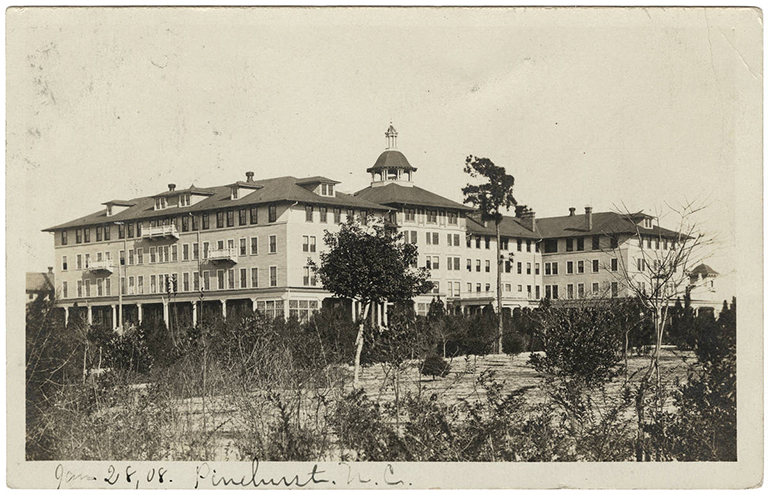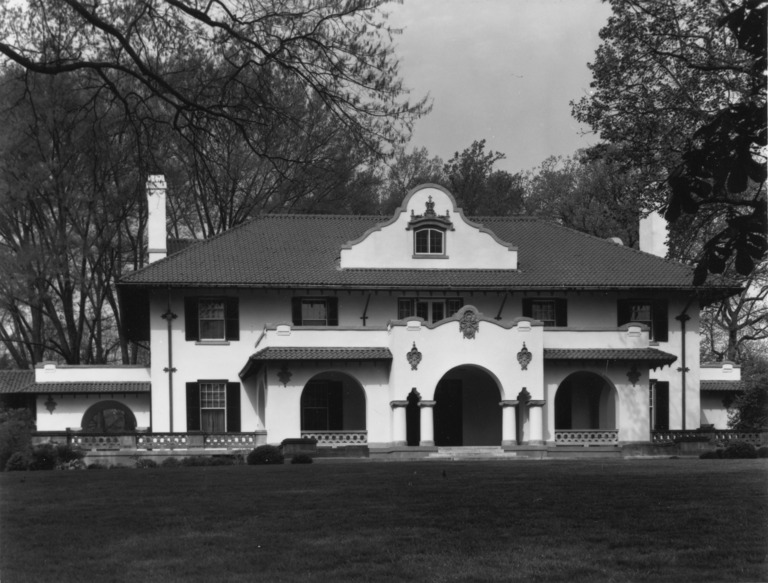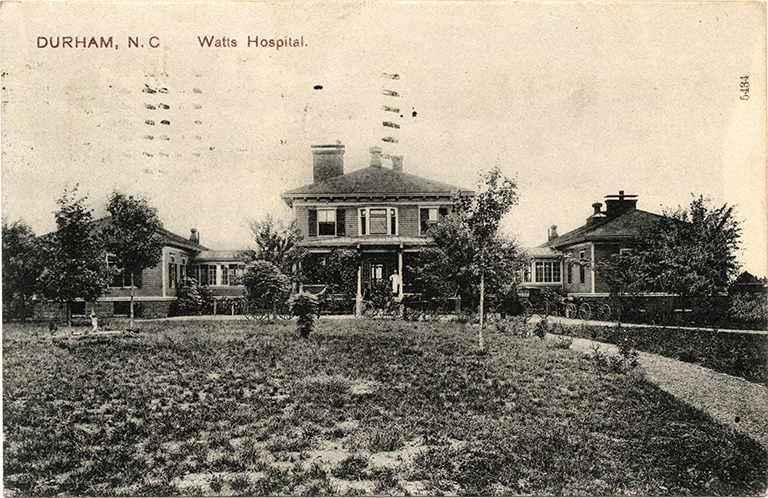Taylor, Bertrand E. (1856-1909)
Variant Name(s):
Bertrand Eugene Taylor
Birthplace:
Vermont, USA
Residences:
- Boston, Massachusetts
- Newton Center, Massachusetts
- Pinehurst, North Carolina
- Durham, North Carolina
Trades:
- Architect
NC Work Locations:
Building Types:
Styles & Forms:
Colonial Revival; Spanish Colonial Revival
Bertrand E. (Eugene) Taylor (1856-August 23, 1909), a Boston architect active in North Carolina, was a native of Vermont. He lived much of his life in Newton Centre, Massachusetts, where he died in 1909. During his series of partnerships with other Boston architects including George D. Rand, Edward Fletcher Stevens, and Henry H. Kendall, Taylor became a specialist in hospital design and also planned other building types. His best known work in North Carolina is in Durham and in the Sand Hills resort community of Pinehurst. He was an associate and later a fellow of the American Institute of Architects and a fellow of the Boston Society of Architects. His last partnership, Kendall and Taylor, continued after his death.
Taylor was trained in the Boston architectural office of Ober and Rand (J. Foster Ober and George D. Rand) and attended special architectural classes at MIT. In the 1880s, after the retirement of senior partner J. Foster Ober, Taylor became a junior partner in Rand and Taylor with Boston architect George D. Rand (1833-1910). This firm and Taylor’s subsequent partnerships with Boston architects Henry H. Kendall and Edward Fletcher Stevens planned numerous hospitals and other edifices in New England and beyond. The principals (see Note below) practiced under various, often overlapping, partnership titles, and at one point in the 1890s, all four—Rand and Taylor, Kendall and Stevens—were in association for key North Carolina projects. It is unclear what roles the various office members took, but from local newspaper coverage it appears that Taylor was the leading presence for the North Carolina works.
Evidently Taylor’s initial project in North Carolina was for Watts Hospital I in Durham. In the 1890s Durham tobacconist and philanthropist George Watts, a partner in W. Duke and Sons since the late 1870s, decided to donate a much-needed and up-to-date public hospital to the booming industrial city where he had made his fortune. The Durham Globe of May 12, 1894, reported that a $25,000 contract had been let to builder C. H. Norton (Charles H. Norton) to construct the hospital from plans by “Rand and Everett” of Boston (no first name given for Everett). Located near Trinity College, it was described by the architects as following “the most perfect plan for a low cost hospital in the United States.” It is likely that the well-connected George Watts had learned of the architects’ reputation as specialists in modern hospital designs and selected the firm on that basis.
By the time Watts Hospital I was completed in 1895, the firm had become Rand and Taylor, with Bertrand E. Taylor, the former draftsman, now a partner. Evidently pleased with the firm’s work, when Watts embarked on building a new residence in Durham—Harwood Hall (1897)—he turned to Rand and Taylor. By this time the two were associated with architects Henry H. Kendall and Edward Fletcher Stevens: plans for the residence are signed Rand and Taylor, Kendall and Stevens of Boston. Local newspaper accounts credited Taylor as the lead architect.
At about the same time, the firm of Rand and Taylor, Kendall and Stevens found another important client in James W. Tufts, a Boston pharmacist, inventor, and philanthropist, who in 1895 founded the model town of Pinehurst in the North Carolina Sand Hills as a healthful resort for northerners who could benefit from the temperate climate, dry air, and “curative virtues in the aromatic breath of the pine.” To realize his vision of a “New England village” in the midst of the pine forests, Tufts employed a series of notable northern designers including the illustrious landscape designer Frederick Law Olmsted to create the curvilinear village plan. The rambling, picturesque Holly Inn (see Lyman F. Sise) opened in February 1896 and was later expanded including elements designed by Rand and Taylor. Tufts soon shifted the purpose of the village by excluding consumptives and creating a pleasant winter resort to appeal to wealthy northerners. He employed Rand and Taylor, Kendall and Stevens—with Taylor again the leading local presence—to plan several of the first buildings in Pinehurst, including a number of “cottages” (see inventory list, Pinehurst National Historic Landmark Designation Report). A prominent early project designed by the firm was the community store—the Pinehurst Department Store—which as described in the Pinehurst Outlook of October 22, 1897, was to be a 2-story structure with shingles at the upper story and a deep porch, and to contain a store, post office, and other facilities. Tufts soon added a golf course that enhanced the community’s appeal.
As Pinehurst grew, Tufts decided to build the Carolina Hotel as the centerpiece of the village and turned to the firm now styled Kendall, Taylor, and Stevens. Pictured in the Pinehurst Outlook of November 3, 1899, the “mammoth” hotel, erected by Greensboro veteran builder William Carter Bain, was touted as the largest hotel in the state, a “model of elegance,” and altogether “up to date.” It was later called “the crowning triumph of Mr. Tufts great dream” (Pinehurst Outlook, December 20, 1901). The firm continued to provide designs in Pinehurst for cottages and other structures. The Pinehurst Outlook of November 9, 1900 noted that “Taylor, Kendall, and Stevens, the well-known Boston architects,” had furnished plans for “Mystic Cottage” as a “model cottage” for Pinehurst, which featured a wraparound porch, fourteen rooms, and “every modern improvement.” After the death of James W. Tufts in 1902, Pinehurst continued to grow under the leadership of his son Leonard Tufts, with buildings designed by additional urban architects including Aymar Embury II and Hobart Upjohn of New York. Local newspapers reported occasional visits by Bertrand E. Taylor for pleasure as well as business.
Within a few years, Stevens had gone his own way, and the firm became Kendall and Taylor. Two important new commissions in Durham developed from the relationship with patron George Watts. Having given Durham its first modern hospital a few years before, Watts decided to establish a much larger and more up-to-date hospital for the fast-growing town. The Raleigh News and Observer of December 10, 1907 announced that plans had been accepted for the new hospital and commented, “The plans were prepared by Mr. Bertrand Taylor, who is said to be the greatest hospital architect in the world.” The article noted that Taylor had also designed the initial Watts Hospital and “the magnificent home of Mr. Watts in this city.” Meanwhile, Taylor had added to his national reputation as hospital specialist with his publications on the subject, including Hospital Planning (1904). He designed the first seven buildings of Watts Hospital II, an imposing and expansive facility on a large campus, which followed the current “pavilion” mode for health care, executed in a “modified Spanish mission type” that created a sunny and cheerful atmosphere. The concept included future expansion of the facility. Taylor died on August 23, 1909, a few months before the hospital was completed and dedicated (New York Times, August 25, 1909; Greensboro Daily News, December 3, 1909). Henry H. Kendall continued to practice under the title of Kendall and Taylor for many more years.
The George Watts connection also garnered the firm of Kendall and Taylor the commission for the Hill House in Durham, an elegant residence in Spanish Revival style. It was built for financier and community leader John Sprunt Hill and his wife Annie Louise Watts Hill, the daughter of George Watts. The Charlotte Observer of March 17, 1911, announced that builders were about to begin work on a residence for Hill to cost $50,000, and that it had been designed by the Kendall and Taylor Company, which had planned the new Watts Hospital. Hill had reportedly traveled north for inspiration for its design. Bertrand Taylor had worked with the Hills on planning their residence before his death, but delays ensured, and the firm of Kendall and Taylor was responsible for its completion. The Hill House stands as one of the sole survivors of the great mansions built for Durham’s late 19th and early 20th century industrial and financial leaders.
Notes on associates of Bertrand E. Taylor (various sources date the architectural partnerships differently):
George Dutton Rand (1833-1910) is best known for his work in Boston’s Back Bay development and for several hospitals. In ca. 1870-1875 he was in partnership with Frank William Weston, and ca. 1877- 1881, he and architect J. Foster Ober operated as Ober and Rand. Rand later formed a partnership with Bertrand E. Taylor, who had been a draftsman and architect in the Ober and Rand office. Rand and Taylor’s works included several buildings at Rollins College in Winter Park, Florida, and Mary Hitchcock Hospital in Hanover, New Hampshire (1889). North Carolina documents indicate the partnership was still in existence in 1897. Rand retired from active practice in about 1904.
Henry H. Kendall (1855-1934) was a fellow of the American Institute of Architects (AIA) and served as its president from 1920 to 1922. Various sources describe him as having been a partner in Kendall and Stevens (1890-1895) and senior partner in Kendall and Taylor and in Kendall, Taylor and Stevens. He also formed Kendall, Stevens, and Lee (1909-1912) with Frederick Clare Lee. As indicated in city directories, however, Kendall continued to practice under the name of Kendall and Taylor as well as on his own for many years after Bertrand E. Taylor’s death in 1909. (The present-day firm of Kendall, Taylor and Company identifies itself as a continuation of the firm, stating that it has been providing architectural services since 1890 and noting on its website, “We are the second oldest architectural firm in Massachusetts, the third oldest in New England, and the thirteenth oldest firm in the country.”)
Edward Fletcher Stevens (1860–1946), an 1883 graduate of MIT, worked for the Boston firm of Allen and Kenway in 1889 and for McKim, Mead and White in 1890. He was associated with Henry H. Kendall in the firms of Kendall and Stevens; Kendall, Taylor, and Stevens; and Kendall, Stevens, and Lee. He also formed with Frederick Clare Lee the partnership of Stevens and Lee, which planned numerous hospitals in Boston and Canada from 1912 to 1933.
- Howard E. Covington, Favored by Fortune: George W. Watts and the Hills of Durham (2004).
- Davyd Foard Hood and Laura A. W. Phillips, Pinehurst Historic District National Historic Landmark Designation Report (1995).
- opendurham.org.
- Claudia P. Roberts (Brown) and Diane E. Lea, The Durham Architectural and Historic Inventory (1982).
- H. McKelden Smith and John B. Flowers, “John Sprunt Hill House,” National Register of Historic Places nomination (1977).
- Henry F. Withey and Elsie Rathburn Withey, Biographical Dictionary of American Architects (Deceased) (1970).
Beacon
Contributors:Bertrand E. Taylor, architectDates:1897; 1913
Location:Pinehurst, Moore CountyStreet Address:65 Carolina Vista Rd., Pinehurst, NC
Status:Altered
Type:Residential
Note:The frame structure was one of several similar buildings erected to provide apartment suites for Pinehurst guests, and it was altered over the years.
Carolina Hotel
Contributors:William Carter Bain, contractor; Hoyt and Haven, architects (1914); Kendall, Taylor and Stevens, architects; Lyman F. Sise, architect (1914); Bertrand E. Taylor, architectDates:1899-1900; 1914 (addition)
Location:Pinehurst, Moore CountyStreet Address:Midpines Rd., Pinehurst, NC
Status:Standing
Type:Commercial
Images Published In:Catherine W. Bishir and Michael T. Southern, A Guide to the Historic Architecture of Piedmont North Carolina (2003).
Note:As his Sand Hills resort community of Pinehurst succeeded, founder James W. Tufts of Boston hired Kendall, Taylor, and Stevens to plan the imposing, 4-story Colonial Revival style Carolina Hotel. Its 350 rooms exceeded the previously built boarding houses and inns in town. Expanded and updated over the years, it maintains its character and stature.
Dartmouth
Contributors:Bertrand E. Taylor, architectDates:1897; ca. 1915
Location:Pinehurst, Moore CountyStreet Address:60 Cherokee Rd., Pinehurst, NC
Status:Altered
Type:Residential
Harwood Hall
Contributors:Charles H. Norton, builder; Rand and Taylor, Kendall and Stevens, architects; Bertrand E. Taylor, architectVariant Name(s):George W. Watts House
Dates:1897
Location:Durham, Durham CountyStreet Address:806 S. Duke St., Durham, NC
Status:No longer standing
Type:Residential
Images Published In:Joel A. Kostyu and Frank A. Kostyu, Durham: A Pictorial History (1978).
opendurham.org.
Claudia P. Roberts (Brown) and Diane E. Lea, The Durham Architectural and Historic Inventory (1982).Note:The stone and shingled mansion in towered Chateauesque style was one of several grand residences built for Durham’s industrial elite in the late 19th and early 20th centuries. It was the second house built in Durham for George Watts, who came to Durham from Baltimore in 1878. With aid from his tobacconist father of Baltimore, he soon became a partner in W. Duke and Sons. (Watts’s first house in Durham was a Queen Anne style residence, completed in 1880 for him and his wife, Laura Valinda BealE Watts, and their daughter Annie, who later married financier and philanthropist John Sprunt Hill). The plans for the 1897 mansion are imprinted with “Rand and Taylor Kendall and Stevens, architects” of Boston. See opendurham.org for the plans and photographs. It was razed in 1961.
Hill House
Contributors:Irving and Casson, interiors; Kendall and Taylor, architects; Thomas Meehan, landscape design; Bertrand E. Taylor, initial architectVariant Name(s):John Sprunt Hill House
Dates:1911-1912
Location:Durham, Durham CountyStreet Address:900 S. Duke St., Durham, NC
Status:Standing
Type:Residential
Images Published In:Catherine W. Bishir and Michael T. Southern, A Guide to the Historic Architecture of Piedmont North Carolina (2003).
Joel A. Kostyu and Frank A. Kostyu, Durham: A Pictorial History (1978).
Claudia P. Roberts (Brown) and Diane E. Lea, The Durham Architectural and Historic Inventory (1982).Note:The Spanish Revival style mansion is Durham’s most opulent survivor of the period revival residences built for the city’s early 20th century elite. It was built for financier and philanthropist John Sprunt Hill and his wife Annie Louise Watts Hill, the only daughter of tobacconist and philanthropist George Watts. Watts purchased the prominent lot on Morehead Hill for his daughter and son-in-law in 1909 as site of their new home. It was located not far from Watts’s own mansion designed by Taylor. According to Howard E. Covington’s book Favored by Fortune: George W. Watts and the Hills of Durham, in 1908 Hill asked Taylor to prepare designs for his new residence, but Taylor’s plans “did not excite Hill or his wife, so they postponed a decision” until after a summer visit to New England and New York “where they hoped to be inspired by designs.” Other delays ensued. After Taylor’s death in 1909, his partner Kendall continued under the firm name for several years and took on the project for the Hills’ residence. The extant plans for the house are marked “revised April 14, 1911,” and various sheets are initialed FCL, GWP (March 25, 1911), and EWO (Bishir, telephone conversation with Joanne Goodwyn, Hill House, Nov. 11, 2014). In recognition of his wife’s participation in civic functions, John Sprunt Hill’s will established a trust, the Annie Watts Hill Fund, so that Hill House would serve as a continuing memorial to her. It has been restored and serves as a meeting place for women’s groups and home to the Junior League of Durham and Orange counties.
Mystic Cottage
Contributors:Kendall, Taylor and Stevens, architects; Bertrand E. Taylor, architectDates:1899-1900
Location:Pinehurst, Moore CountyStreet Address:105 Magnolia Ln, Pinehurst, NC
Status:Standing
Type:Residential
Note:The 2-story, shingled house with wraparound porch was built as a “model cottage” and served as the first Pinehurst home of Leonard Tufts, the son and successor of Pinehurst founder James W. Tufts.
Pinehurst Department Store
Contributors:Rand and Taylor, Kendall and Stevens, architects; Bertrand E. Taylor, architectDates:1897
Location:Pinehurst, Moore CountyStreet Address:Corner of Cherokee Rd. and Chinquapin Rd., Pinehurst, NC
Status:Standing
Type:Commercial
Note:The shingled and German-sided building, with ells linked by a porch, displays the informal style of several early Pinehurst buildings.
The Harvard
Contributors:William Carter Bain, contractor; Kendall, Taylor and Stevens, architects; Bertrand E. Taylor, architectDates:1901
Location:Pinehurst, Moore CountyStreet Address:25 Chinquapin Rd., Pinehurst, NC
Status:Standing
Type:Commercial
Note:The Queen Anne style structure was built as a small hotel to supplement other facilities in early Pinehurst; an annex was built in the 1920s.
Watts Hospital I
Contributors:Everett and Rand, architects; Charles H. Norton, builder; Rand and Taylor, architects; Bertrand E. Taylor, architectDates:1894-1895
Location:Durham, Durham CountyStreet Address:Main St. at Buchanan Blvd., Durham, NC
Status:Moved
Type:Health Care
Images Published In:Joel A. Kostyu and Frank A. Kostyu, Durham: A Pictorial History (1978).
Claudia P. Roberts (Brown) and Diane E. Lea, The Durham Architectural and Historic Inventory (1982).Note:The original Watts Hospital, dedicated in 1895, was a two-story structure with flanking wings. The central portion was moved to 302 Watts St. and converted to a private residence.
Watts Hospital II
Contributors:Kendall and Taylor, architects; Arthur C. Nash, architect; Bertrand E. Taylor, architect; John T. Wilson, builderVariant Name(s):North Carolina School of Science and Mathematics
Dates:1908-1910 and later
Location:Durham, Durham CountyStreet Address:1912 W. Club Blvd., Durham, NC
Status:Standing
Type:Health Care
Images Published In:Joel A. Kostyu and Frank A. Kostyu, Durham: A Pictorial History (1978).
Claudia P. Roberts (Brown) and Diane E. Lea, The Durham Architectural and Historic Inventory (1982).Note:For George Watts’s second hospital given to Durham, Taylor planned the initial seven buildings of the campus in a “modified Spanish mission type” laid out according to current standards of medical treatment. When the contract for the project was announced in 1908, the Charlotte Observer ofApril 9 lauded Taylor as the “greatest hospital architect in the world.” Open porches and balconies, many windows, and a cheerful décor were intended to enhance residents’ health. The Greensboro Daily News of December 3, 1909, reported at the dedication of the hospital that its architect, Taylor, had died before it was completed, and cited Wilson of Richmond (who had built Richmond’s Jefferson Hotel) as the builder. The following year, the Manufacturers’ Record (March 10, 1910), noted Kendall, Taylor, and Company as architects of an additional pavilion at the Watts Hospital. Other structures including the Valinda Beale Watts Pavilion (1926) were planned by architect Arthur C. Nash and followed similar concepts. In the 1980s the facility was renovated to an innovative state school.




